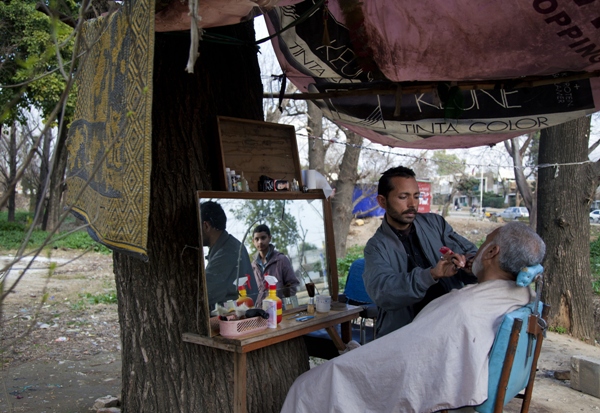
A relief panel from a second-century funerary monument adorned with a scene from a butcher shop.
ROME — “If a man were called to fix the period in the history of the
world during which the condition of the human race was most happy and
prosperous, he would without hesitation, name that which elapsed from
the death of Domitian to the accession of Commodus,” Edward Gibbon wrote
in “Decline and Fall of the Roman Empire.”
In so declaring, the English historian was following the lead of a
number of Roman and Renaissance authors, who took an equally rosy view
of the state of the empire and humanity during the second century.
At first glance, by its very title “The Age of Equilibrium, 98-180 A.D.:
Trajan, Hadrian, Antoninus Pius, Marcus Aurelius,” the third in a
series of exhibitions on art and society in ancient Rome at the
Capitoline Museums, seems to be endorsing this traditional historical
assessment that stretches from Pliny the Younger through Machiavelli and
Gibbon into modern times.
But a strength of this latest show, curated by Eugenio La Rocca and
Claudio Parisi Presicce with Annalisa Monaco, and especially of its
catalog, is that, while achievements are recognized, darker aspects are
not whitewashed and the dominant role played by propaganda in public art
of the era is highlighted.
The reputation the second century won as a golden age was substantially
based on the unusual stability of the political establishment during
this period and on the economic prosperity that helped to nurture.
That stability was largely the result of the abandonment of the direct
hereditary principle in the imperial succession in favor of the practice
of adopting suitably talented candidates. Thus Nerva adopted Trajan in
97 A.D.; Trajan’s second cousin Hadrian succeeded him in 117; Hadrian
adopted Antoninus Pius in 138, who adopted his son-in-law Marcus
Aurelius as his own successor.
In a return to the old system, Marcus Aurelius was succeeded in 180 by
his son Commodus, whose behavior became increasingly deranged. As
everyone who has seen “Gladiator” now knows, Commodus developed a
penchant for taking a personal part in gladiatorial displays (yet in
reality met his end not in the arena but when he was strangled in his
bath).
The first room of the show, “The Leading Actors,” introduces us to the
stars of the epoch in the form of more than 40 portrait statues and
busts of the emperors, their wives, daughters and favorites.
What is immediately striking in the representation of the male players
is that they are so often depicted in some form of military dress.
This introduces one of the central paradoxes of this notional age of
peace and harmony. For while the Emperor Augustus, a victorious general
and founder of the imperial system, was seldom represented as a warrior,
the emperors of the second century relentlessly emphasized this role.
The empire reached its greatest extent — an area of 3.5 million square
kilometers, or 1.35 million square miles, with an estimated population
of 55 million — during the reign of Trajan. Much of what he did to
transform Rome is still visible from the Capitoline Museums or within a
few minutes’ walk. The Trajan Forum was the largest and grandest of all
the forums and the so-called Trajan Markets on the hillside above are
well preserved. Nearby are the remains of the huge Trajan Baths on the
Oppian Hill — the first to include a library, park and cultural complex —
which was to serve as the model for all subsequent monumental baths.
Vast infrastructure projects included a new port at Ostia, canals,
quays, aqueducts and sewers.
But these improvements were mainly financed by war booty, especially
what was gained from 101 to 106 during the conquest of Dacia — a kingdom
centered on present-day Romania and Moldova.
These wars were celebrated in the spiraling friezes of Trajan’s Column
on the edge of the Trajan Forum, the first column of its kind and the
first depictions of an emperor on campaign. The Trajan Forum itself was
adorned with multiple images of the Dacian Wars in the form of statues,
reliefs and decorative elements of the victorious emperor and of
defeated Dacians.
Hadrian, who had fought in the Dacian Wars, abandoned his predecessor’s
policy of expansion and concentrated on consolidating the empire’s
existing borders. But despite his image as a peacemaker, he put down the
Jewish revolt led by the self-declared messiah Bar Kokhba (132-135)
with resolute savagery, refounding Jerusalem as a pagan military colony.
Hadrian, too, left his monumental mark on Rome, most prominently in the
Pantheon and his mausoleum, now Castel Sant’Angelo.
Of all these emperors, Marcus Aurelius, thanks to his “Meditations,” has
gone down in history as the ideal Roman philosopher-emperor. Yet his
contemporary public image in art remained that of the warrior, as can be
seen in the busts and reliefs in a subsequent section of the exhibition
of “Historical Reliefs,” which continues the theme of this art as
propaganda.
The reliefs lead on to the circular hall that is now the home of the
magnificent gilded bronze equestrian statue of Marcus Aurelius, as the
armor-clad victor over the German tribes. The victory is also celebrated
on the Column of Marcus Aurelius in Piazza Colonna, which shows him
leading his troops and includes scenes of the massacre of prisoners and
of violence being inflicted on women and children.
This bellicose imagery, so ubiquitous in the Trajan Forum as to turn it
into a kind of Dacian War theme park, was not confined to the official
depiction of emperors and their deeds, as is illustrated in a parallel
section in the first room of the exhibition on “The Language of Art.”
Tumultuous battle scenes became popular on sarcophagi during this
period. There are three examples here, all revolving around the crushing
of mythical and actual barbarian tribes.
The second century saw a progressive shift away from cremation in favor
of burial (and interment in sarcophagi for those who could afford it),
perhaps in imitation of Hellenistic practices. As the last section of
the exhibition, entitled “Tombs,” demonstrates, this is a trend that
encouraged more elaborate sepulchers and also had the fortuitous effect
of enriching posterity’s knowledge of various aspects of Roman everyday
life.
This section opens with the famous sarcophagus, remains and grave goods
of the teenage girl Crepereia Tryphaena, unearthed close to the Tiber in
1889. She was not only buried with her own jewelry, including a
precious brooch with an engraved amethyst cameo, a gold necklace with
beryl pendants, pearl earrings and a gold engagement or wedding ring,
but also an exquisitely fashioned ivory doll with articulated limbs.
Crepereia’s body was placed on her side, with her head inclined toward
the doll. Along with this lovely plaything were buried the doll’s
miniature clothes, necklace, earrings and other jewelry as well as tiny
combs, mirrors and a little jewel case, faced in ivory and bone. The
doll’s minutely carved hairstyle is a meticulously realized version of
one made fashionable by the Emperor Antoninus Pius’s wife Faustina Major
and their daughter Faustina Minor.
Crepereia’s family name indicates that they were freed slaves, perhaps
originally from Syria or Egypt, but they had clearly risen in the ranks
and were likely attached in some way to the emperor since the tomb was
within the estate of an imperial villa. The luxury doll (probably made
in Alexandria) and expensive jewelry also indicate the family’s
prosperity.
But as some of the subsequent sarcophagi and funerary panels show,
monuments also preserved information about more humble classes. One
panel here has a vivid relief of a Roman butcher shop. Another pair of
reliefs gives two scenes of a deceased artisan’s life: one of him at his
anvil and another in an apron behind the counter of his shop, proudly
displaying for sale an array of the metal tools he had manufactured.
The Age of Equilibrium, 98-180 A.D. Trajan, Hadrian, Antoninus Pius, Marcus Aurelius. Capitoline Museums, Rome. Through May 5.





 Pictured above is a group of Muslims
in Karachi, Pakistan, in procession for the Prophet Muhammad's birthday.
Pictured above is a group of Muslims
in Karachi, Pakistan, in procession for the Prophet Muhammad's birthday. 